A Review of Recent Investigations on Flow and Heat Transfer Enhancement in Cooling Channels Embedded with Triply Periodic Minimal Surfaces (TPMS)
Abstract
:1. Introduction
2. Effects of TPMS Design Variables on Flow and Heat Transfer
2.1. Parameter Definitions
2.2. Porosity
2.2.1. Equivalent Porosity
2.2.2. Varying the Porosity
2.3. Wall Thickness
2.4. Unit Cell Size
3. Comparison between Conventional Cooling and TPMS-Based Structures
3.1. Two Fluid Heat Exchangers
3.2. Forced Convective Heat Sinks
3.3. Other Applications Related to Flow, Heat, and Mass Transfer
4. Additive Manufacturing Methods for TPMS-Based Cooling Channels
5. Recommendations for Future Research
- Experimental investigations on heat transfer characteristics with different TPMS topologies, porosities, wall thicknesses, and unit cell sizes are required for heat sink applications, especially under turbulent flow regimes. The heat transfer characteristics on the endwall can be obtained using liquid crystal methods, which have been achieved for the lattice-frame material in previous studies [100]. Moreover, to explore the full potential of the TPMS heat transfer, the metallic TPMS structures can be additively manufactured; then, the thermocouples can be used to measure the heat transfer dissipation in steady-state experiments [101,102]. Some examples of the TPMS structures, additively manufactured by selective laser melting (SLM) using stainless steel, are shown in Figure 24;
- Apart from computational fluid dynamics (CFD) investigations, magnetic resonance imaging (MRI), which has been used by Clark et al. [30], is an appropriate technique for understanding the flow mechanisms of complex TPMS structures;
- The different cooling channel configurations can be further investigated, e.g., circular tube, narrow duct, wedge-shaped channel, etc., which could provide insight into flow and heat transfer characteristics when using TPMS structures. The uniform and graded TPMS structures can also be tested in other cooling applications, e.g., film cooling channels [103], a trailing edge of gas turbine blades [104], and recuperator heat exchangers for a gas turbine system [46], to further enhance thermal performance;
- The correlations from the TPMS cooling structures are rarely observed in previous works, particularly at high Reynolds numbers. Therefore, the correlations from a wide range of parameters have to be formulated to estimate the heat transfer and pressure loss in the cooling channel with different TPMS structures.
- Previous studies have used optimization methods to find the optimal lattice configuration structure [105]. Modrek et al. [106] also employed topology optimization with two mapping approaches to optimize natural convective heat sinks with solid- and sheet-Gyroid structures. Therefore, optimization methods are encouraged to find the optimal configurations of the forced convective cooling channel embedded with TPMS structures.
6. Conclusions
- With the same porosity, more complex TPMS structures, e.g., Diamond and Gyroid models, provide high heat transfer as the Reynolds numbers increase but cause high-pressure loss. This is due to their tortuosity topologies and larger surface areas, significantly changing the flow characteristics. For heat sink applications, the graded TPMS structure along the flow direction could provide better thermal performance than the uniform one due to significantly decreased pressure loss with maintaining high heat transfer in the channel.
- The convective heat transfer coefficient and friction factor inversely vary with the porosity for most of the sheet-TPMS structures, except for the Primitive model, because a large high-speed area presents in the lower porosity model along the flow direction, considerably interacting with the heating walls.
- Different TPMS topologies with the same wall thickness have different porosities and surface areas, resulting in flow and heat transfer variation. Under laminar flow, the Diamond heat exchanger shows the best thermal performance, while for turbulent flow regimes, the Gyroid heat transfer exhibits better due to increased turbulent kinetic energy. The larger wall thickness provides higher convective heat transfer and pressure loss; however, due to the TPMS topologies and unit cell sizes, the wall thickness variation could affect the flow field and heat transfer enhancement differently.
- The comparisons with conventional cooling structures for the two-fluid heat exchangers show that the thermal performance is higher with the TPMS due to the smooth curvatures and large surface areas. Meanwhile, the solid-TPMS structures outperform the sheet-based ones due to much lower pressure loss for heat sink applications.
- Powder bed fusion (PBF), an additive manufacturing method, is the most used technique to fabricate TPMS-based cooling channels due to a variety of usable materials. However, recent investigations have only focused on the small size of TPMS cooling channels.
Author Contributions
Funding
Acknowledgments
Conflicts of Interest
Appendix A
References
- Pan, C.; Han, Y.; Lu, J. Design and optimization of lattice structures: A review. Appl. Sci. 2020, 10, 6374. [Google Scholar] [CrossRef]
- Kaur, I.; Singh, P. State-of-the-art in heat exchanger additive manufacturing. Int. J. Heat Mass Transf. 2021, 178, 121600. [Google Scholar] [CrossRef]
- Kaur, I.; Singh, P. Critical evaluation of additively manufactured metal lattices for viability in advanced heat exchangers. Int. J. Heat Mass Transf. 2021, 168, 120858. [Google Scholar] [CrossRef]
- Al-Ketan, O.; Al-Rub, R.K.A. Multifunctional Mechanical Metamaterials Based on Triply Periodic Minimal Surface Lattices. Adv. Eng. Mater. 2019, 21, 1900524. [Google Scholar] [CrossRef]
- Voicu, A.D.; Hadăr, A.; Vlăsceanu, D. Benefits of 3D printing technologies for aerospace lattice structures. Sci. Bull. Nav. Acad. 2021, 24, 8–16. [Google Scholar] [CrossRef]
- Feng, J.; Fu, J.; Yao, X.; He, Y. Triply periodic minimal surface (TPMS) porous structures: From multi-scale design, precise additive manufacturing to multidisciplinary applications. Int. J. Extrem. Manuf. 2022, 4, 022001. [Google Scholar] [CrossRef]
- Al-Ketan, O.; Rowshan, R.; Al-Rub, R.K.A. Topology-mechanical property relationship of 3D printed strut, skeletal, and sheet based periodic metallic cellular materials. Addit. Manuf. 2018, 19, 167–183. [Google Scholar] [CrossRef]
- Xiao, Z.; Yang, Y.; Xiao, R.; Bai, Y.; Song, C.; Wang, D. Evaluation of topology-optimized lattice structures manufactured via selective laser melting. Mater. Des. 2018, 143, 27–37. [Google Scholar] [CrossRef]
- Kazemi, H.; Vaziri, A.; Norato, J.A. Multi-material topology optimization of lattice structures using geometry projection. Comput. Methods Appl. Mech. Eng. 2020, 363, 112895. [Google Scholar] [CrossRef] [Green Version]
- Beyer, C.; Figueroa, D. Design and Analysis of Lattice Structures for Additive Manufacturing. J. Manuf. Sci. Eng. Trans. ASME 2016, 138, 121014. [Google Scholar] [CrossRef]
- Dong, L.; Deshpande, V.; Wadley, H. Mechanical response of Ti-6Al-4V octet-truss lattice structures. Int. J. Solids Struct. 2015, 60, 107–124. [Google Scholar] [CrossRef]
- Ekade, P.; Krishnan, S. Fluid flow and heat transfer characteristics of octet truss lattice geometry. Int. J. Therm. Sci. 2019, 137, 253–261. [Google Scholar] [CrossRef]
- Liang, D.; He, G.; Chen, W.; Chen, Y.; Chyu, M.K. Fluid flow and heat transfer performance for micro-lattice structures fabricated by Selective Laser Melting. Int. J. Therm. Sci. 2022, 172, 107312. [Google Scholar] [CrossRef]
- Xu, L.; Ruan, Q.; Shen, Q.; Xi, L.; Gao, J.; Li, Y. Optimization design of lattice structures in internal cooling channel with variable aspect ratio of gas turbine blade. Energies 2021, 14, 3954. [Google Scholar] [CrossRef]
- Ho, J.Y.; Leong, K.C.; Wong, T.N. Experimental and numerical investigation of forced convection heat transfer in porous lattice structures produced by selective laser melting. Int. J. Therm. Sci. 2019, 137, 276–287. [Google Scholar] [CrossRef]
- Han, L.; Che, S. An Overview of Materials with Triply Periodic Minimal Surfaces and Related Geometry: From Biological Structures to Self-Assembled Systems. Adv. Mater. 2018, 30, e1705708. [Google Scholar] [CrossRef]
- Schwarz, H.A. Gesammelte Mathematische Abhandlungen; Springer: Berlin/Heidelberg, Germany, 1890. [Google Scholar]
- Neovius, E.R. Bestimmung Zweier Spezieller Periodischer Minimalflächen, Akad; Abhandlungen: Helsinki, Finland, 1883. [Google Scholar]
- Schoen, A.H. Infinite Periodic Minimal Surfaces without Self-Intersections; NASA: Washington, DC, USA, 1970. [CrossRef]
- Gandy, P.J.F.; Klinowski, J. Nodal surface approximations to the zero equipotential surfaces for cubic lattices. J. Math. Chem. 2002, 31, 1–16. [Google Scholar] [CrossRef]
- Helou, M.; Kara, S. Design, analysis and manufacturing of lattice structures: An overview. Int. J. Comput. Integr. Manuf. 2018, 31, 243–261. [Google Scholar] [CrossRef]
- Al-Ketan, O.; Al-Rub, R.K.A. MSLattice: A free software for generating uniform and graded lattices based on triply periodic minimal surfaces. Mater. Des. Process. Commun. 2020, 3, 1–10. [Google Scholar] [CrossRef]
- Jones, A.; Leary, M.; Bateman, S.; Easton, M. TPMS Designer: A tool for generating and analysing triply periodic minimal surfaces. Softw. Impacts 2021, 10, 100167. [Google Scholar] [CrossRef]
- Speirs, M.; van Hooreweder, B.; van Humbeeck, J.; Kruth, J.P. Fatigue behaviour of NiTi shape memory alloy scaffolds produced by SLM, a unit cell design comparison. J. Mech. Behav. Biomed. Mater. 2017, 70, 53–59. [Google Scholar] [CrossRef] [PubMed]
- Khan, K.A.; Al-Rub, R.K.A. Time dependent response of architectured Neovius foams. Int. J. Mech. Sci. 2017, 126, 106–119. [Google Scholar] [CrossRef]
- Wang, N.; Meenashisundaram, G.K.; Chang, S.; Fuh, J.Y.H.; Dheen, S.T.; Kumar, A.S. A comparative investigation on the mechanical properties and cytotoxicity of Cubic, Octet, and TPMS gyroid structures fabricated by selective laser melting of stainless steel 316L. J. Mech. Behav. Biomed. Mater. 2022, 129, 105151. [Google Scholar] [CrossRef] [PubMed]
- Teng, F.; Sun, Y.; Guo, S.; Gao, B.; Yu, G. Topological and Mechanical Properties of Different Lattice Structures Based on Additive Manufacturing. Micromachines 2022, 13, 1017. [Google Scholar] [CrossRef]
- Hussain, S.; Ghopa, W.A.W.; Singh, S.S.K.; Azman, A.H.; Abdullah, S. Experimental and Numerical Vibration Analysis of Octet-Truss-Lattice-Based Gas Turbine Blades. Metals 2022, 12, 340. [Google Scholar] [CrossRef]
- Ouda, M.; Al-Ketan, O.; Sreedhar, N.; Ali, M.I.H.; Al-Rub, R.K.A.; Hong, S.; Arafat, H.A. Novel static mixers based on triply periodic minimal surface (TPMS) architectures. J. Environ. Chem. Eng. 2020, 8, 104289. [Google Scholar] [CrossRef]
- Clarke, D.A.; Dolamore, F.; Fee, C.J.; Galvosas, P.; Holland, D.J. Investigation of flow through triply periodic minimal surface-structured porous media using MRI and CFD. Chem. Eng. Sci. 2021, 231, 116264. [Google Scholar] [CrossRef]
- Ali, D.; Ozalp, M.; Blanquer, S.B.G.; Onel, S. Permeability and fluid flow-induced wall shear stress in bone scaffolds with TPMS and lattice architectures: A CFD analysis. Eur. J. Mech. B Fluids 2020, 79, 376–385. [Google Scholar] [CrossRef]
- Poltue, T.; Karuna, C.; Khrueaduangkham, S.; Seehanam, S.; Promoppatum, P. Design exploration of 3D-printed triply periodic minimal surface scaffolds for bone implants. Int. J. Mech. Sci. 2021, 211, 106762. [Google Scholar] [CrossRef]
- Montazerian, H.; Zhianmanesh, M.; Davoodi, E.; Milani, A.S.; Hoorfar, M. Longitudinal and radial permeability analysis of additively manufactured porous scaffolds: Effect of pore shape and porosity. Mater. Des. 2017, 122, 146–156. [Google Scholar] [CrossRef]
- Liu, H.L.; Hwang, W.R. Permeability prediction of fibrous porous media with complex 3D architectures. Compos. Part A Appl. Sci. Manuf. 2012, 43, 2030–2038. [Google Scholar] [CrossRef]
- Huang, X.; Zhou, W.; Deng, D. Effective diffusion in fibrous porous media: A comparison study between lattice boltzmann and pore network modeling methods. Materials 2021, 14, 756. [Google Scholar] [CrossRef] [PubMed]
- Abueidda, D.W.; Al-Rub, R.K.A.; Dalaq, A.S.; Lee, D.W.; Khan, K.A.; Jasiuk, I. Effective conductivities and elastic moduli of novel foams with triply periodic minimal surfaces. Mech. Mater. 2016, 95, 102–115. [Google Scholar] [CrossRef]
- Mirabolghasemi, A.; Akbarzadeh, A.H.; Rodrigue, D.; Therriault, D. Thermal conductivity of architected cellular metamaterials. Acta Mater. 2019, 174, 61–80. [Google Scholar] [CrossRef]
- Wang, F.; Jiang, H.; Chen, Y.; Li, X. Predicting thermal and mechanical performance of stochastic and architected foams. Int. J. Heat Mass Transf. 2021, 171, 121139. [Google Scholar] [CrossRef]
- Calmidi, V.V.; Mahajan, R.L. The effective thermal conductivity of high porosity fibrous metal foams. J. Heat Transf. 1999, 121, 466–471. [Google Scholar] [CrossRef]
- Wulf, R.; Mendes, M.A.A.; Skibina, V.; Al-Zoubi, A.; Trimis, D.; Ray, S.; Gross, U. Experimental and numerical determination of effective thermal conductivity of open cell FeCrAl-alloy metal foams. Int. J. Therm. Sci. 2014, 86, 95–103. [Google Scholar] [CrossRef]
- Ni, L.; Chen, Z.; Mukhopadhyaya, P.; Zhang, X.; Wu, Q.; Yu, Q.; Miu, G. Numerical simulation on thermal performance of vacuum insulation panels with fiber /powder porous media based on CFD method. Int. J. Therm. Sci. 2022, 172, 107320. [Google Scholar] [CrossRef]
- Qureshi, Z.A.; Al-Omari, S.A.B.; Elnajjar, E.; Al-Ketan, O.; Al-Rub, R.A. Nature-inspired triply periodic minimal surface-based structures in sheet and solid configurations for performance enhancement of a low-thermal-conductivity phase-change material for latent-heat thermal-energy-storage applications. Int. J. Therm. Sci. 2022, 173, 107361. [Google Scholar] [CrossRef]
- Qureshi, Z.A.; Al-Omari, S.A.B.; Elnajjar, E.; Al-Ketan, O.; Al-Rub, R.A. Using triply periodic minimal surfaces (TPMS)-based metal foams structures as skeleton for metal-foam-PCM composites for thermal energy storage and energy management applications. Int. Commun. Heat Mass Transf. 2021, 124, 105265. [Google Scholar] [CrossRef]
- Catchpole-Smith, S.; Sélo, R.R.J.; Davis, A.W.; Ashcroft, I.A.; Tuck, C.J.; Clare, A. Thermal conductivity of TPMS lattice structures manufactured via laser powder bed fusion. Addit. Manuf. 2019, 30, 100846. [Google Scholar] [CrossRef]
- Liu, B.; Ma, B.; Wang, X.; Zhang, L.; Ye, J. Experimental Study on the Heat Transfer Performance of Porous Metal Fiber Sintered Sheet. In Proceedings of the 2016 International Conference on Advances in Energy, Environment and Chemical Science, Changsha, China, 23–24 April 2016; Atlantis Press: Paris, France, 2016; pp. 314–321. [Google Scholar] [CrossRef] [Green Version]
- Wang, W.; Li, B.; Tan, Y.; Li, B.; Shuai, Y. Multi-objective optimal design of NACA airfoil fin PCHE recuperator for micro-gas turbine systems. Appl. Therm. Eng. 2022, 204, 117864. [Google Scholar] [CrossRef]
- Kaur, I.; Singh, P. Flow and thermal transport characteristics of Triply-Periodic Minimal Surface (TPMS)-based gyroid and Schwarz-P cellular materials. Numer. Heat Transf. Part A Appl. 2021, 79, 553–569. [Google Scholar] [CrossRef]
- Khalil, M.; Ali, M.I.H.; Khan, K.A.; Al-Rub, R.A. Forced convection heat transfer in heat sinks with topologies based on triply periodic minimal surfaces. Case Stud. Therm. Eng. 2022, 38, 102313. [Google Scholar] [CrossRef]
- Yinzheng, Z. Numerical Analysis on Fluid-solid Coupling Cooling of Minimal Surface Lattice Structure. J. Phys. Conf. Ser. 2019, 1187, 032070. [Google Scholar] [CrossRef]
- Raja, S.; Hamulczuk, D.; Carlsson, S.D. Exploring a New Energy-Efficient Way to Heat Water: Design of a Heat Exchanger for Laundry Machine Applications Produced Using Additive Manufacturing; Chalmers University of Technology: Gothenburg, Sweden, 2020. [Google Scholar]
- Chandrasekaran, G. Arizona State University: Tempe, AZ, USA, 2018. Available online: https://core.ac.uk/download/pdf/158457046 (accessed on 13 October 2021).
- Attarzadeh, R.; Rovira, M.; Duwig, C. Design analysis of the ”Schwartz D” based heat exchanger: A numerical study. Int. J. Heat Mass Transf. 2021, 177, 121415. [Google Scholar] [CrossRef]
- Al-Ketan, O.; Ali, M.; Khalil, M.; Rowshan, R.; Khan, K.A.; Al-Rub, R.K.A. Forced Convection Computational Fluid Dynamics Analysis of Architected and Three-Dimensional Printable Heat Sinks Based on Triply Periodic Minimal Surfaces. J. Therm. Sci. Eng. Appl. 2021, 13, 021010. [Google Scholar] [CrossRef]
- Passos, A.G.P. Laminar Flow and Heat Transfer in Triply Periodic Minimal Surfaces; Lund University: Lund, Sweden, 2020; Available online: https://fenix.tecnico.ulisboa.pt/downloadFile/1126295043836646/ThesisAndrePass%0Aos.pdf (accessed on 9 October 2021).
- Iyer, J.; Moore, T.; Nguyen, D.; Roy, P.; Stolaroff, J. Heat transfer and pressure drop characteristics of heat exchangers based on triply periodic minimal and periodic nodal surfaces. Appl. Therm. Eng. 2022, 209, 118192. [Google Scholar] [CrossRef]
- Reynolds, B.W. Simulation of Flow and Heat Transfer in 3D Printable Triply Periodic Minimal Surface Heat Exchangers; University of Canterbury: Christchurch, New Zealand, 2020. [Google Scholar]
- Ali, M.I.H.; Al-Ketan, O.; Baobaid, N.; Khan, K.; Al-Rub, R.K.A. A study on the fluid flow and heat transfer for a porous architected heat sink using the idea of CFD modelling. In Proceedings of the ASME 2019 International Mechanical Engineering Congress and Exposition, Salt Lake City, UT, USA, 11–14 November 2019; Volume 8, pp. 1–6. [Google Scholar] [CrossRef]
- Cheng, Z.; Li, X.; Xu, R.; Jiang, P. Investigations on porous media customized by triply periodic minimal surface: Heat transfer correlations and strength performance. Int. Commun. Heat Mass Transf. 2021, 129, 105713. [Google Scholar] [CrossRef]
- Hagari, T.; Ishida, K.; Takeishi, K.; Komiyama, M.; Oda, Y. Experimental Study on Local Heat Transfer in a Rotating, Two-Pass Cooling Channel with Dense Array of Turbulence Promoters with Naphthalene Sublimation Method. In Proceedings of the ASME Turbo Expo, American Society of Mechanical Engineers, Düsseldorf, Germany, 16–20 June 2014; pp. 1–12. [Google Scholar] [CrossRef]
- Oh, I.; Kim, K.; Lee, D.; Park, J.; Cho, H. Local heat/mass transfer and friction loss measurement in a rotating matrix cooling channel. ASME J. Heat Transf. 2012, 134, 011901. [Google Scholar] [CrossRef]
- Park, J.; Kim, K.; Lee, D.; Cho, H.; Chyu, M. Heat transfer in rotating channel with inclined pin-fins. ASME J. Turbomach. 2011, 133, 021003. [Google Scholar] [CrossRef]
- Li, W.; Yu, G.; Yu, Z. Bioinspired heat exchangers based on triply periodic minimal surfaces for supercritical CO2 cycles. Appl. Therm. Eng. 2020, 179, 115686. [Google Scholar] [CrossRef]
- Winterton, R.H.S. Where did the Dittus and Boelter equation come from? Int. J. Heat Mass Transf. 1998, 41, 809–810. [Google Scholar] [CrossRef]
- Hager, W.H. Blasius: A life in research and education. Exp. Fluids 2003, 34, 566–571. [Google Scholar] [CrossRef] [Green Version]
- Cheng, Z.; Xu, R.; Jiang, P.X. Morphology, flow and heat transfer in triply periodic minimal surface based porous structures. Int. J. Heat Mass Transf. 2021, 170, 120902. [Google Scholar] [CrossRef]
- Sreedhar, N.; Thomas, N.; Al-Ketan, O.; Rowshan, R.; Hernandez, H.H.; Al-Rub, R.K.A.; Arafat, H.A. Mass transfer analysis of ultrafiltration using spacers based on triply periodic minimal surfaces: Effects of spacer design, directionality and voidage. J. Memb. Sci. 2018, 561, 89–98. [Google Scholar] [CrossRef]
- Thomas, N.; Sreedhar, N.; Al-Ketan, O.; Rowshan, R.; Al-Rub, R.K.A.; Arafat, H. 3D printed triply periodic minimal surfaces as spacers for enhanced heat and mass transfer in membrane distillation. Desalination 2018, 443, 256–271. [Google Scholar] [CrossRef]
- Qureshi, Z.A.; Al-Omari, S.A.B.; Elnajjar, E.; Al-Ketan, O.; Al-Rub, R.A. On the effect of porosity and functional grading of 3D printable triply periodic minimal surface (TPMS) based architected lattices embedded with a phase change material. Int. J. Heat Mass Transf. 2022, 183, 122111. [Google Scholar] [CrossRef]
- Karuna, C.; Poltue, T.; Khrueaduangkham, S.; Promoppatum, P. Mechanical and fluid characteristics of triply periodic minimal surface bone scaffolds under various functionally graded strategies. J. Comput. Des. Eng. 2022, 9, 1258–1278. [Google Scholar] [CrossRef]
- Genç, A.M.; Vatansever, C.; Koçak, M.; Karadeniz, Z.H. Investigation of Additively Manufactured Triply Periodic Minimal Surfaces as an Air-to-Air Heat Exchanger. In Proceedings of the REHVA 14th HVAC Word Congress, Rotterdam, The Netherlands, 22–25 May 2022. [Google Scholar] [CrossRef]
- Femmer, T.; Kuehne, A.J.C.; Wessling, M. Estimation of the structure dependent performance of 3-D rapid prototyped membranes. Chem. Eng. J. 2015, 273, 438–445. [Google Scholar] [CrossRef]
- Attarzadeh, R.; Attarzadeh-Niaki, S.H.; Duwig, C. Multi-objective optimization of TPMS-based heat exchangers for low-temperature waste heat recovery. Appl. Therm. Eng. 2022, 212, 118448. [Google Scholar] [CrossRef]
- Zimmer, A.; PachecoAraújo, J.D.; Andreassen, K.A.; Grande, C.A. Effect of Manufacturing Techniques in Pressure Drop on Triple Periodical Minimal Surface Packings. Chem. Ing. Tech. 2021, 93, 967–973. [Google Scholar] [CrossRef]
- Al-Ketan, O.; Pelanconi, M.; Ortona, A.; Al-Rub, R.K.A. Additive manufacturing of architected catalytic ceramic substrates based on triply periodic minimal surfaces. J. Am. Ceram. Soc. 2019, 102, 6176–6193. [Google Scholar] [CrossRef]
- Nguyen, D.T.; Roy, P.; Beck, V.A.; Stolaroff, J.K. Triply Periodic Minimal Surface Heat Exchangers for Supercritical CO2 Cycles. In Proceedings of the 14th International Conference on Greenhouse Gas Control Technologies, Melbourne, Australia, 21–25 October 2018; pp. 1–2. [Google Scholar]
- Slaughter, V.B. Method of using Minimal Surfaces and Minimal Skeletons to Make Heat Exchanger Components. U.S. Patent US7866377B2, 11 January 2011. Available online: https://patents.google.com/patent/US7866377B2/en (accessed on 13 September 2022).
- Peng, H.; Gao, F.; Hu, W. Design, Modeling and Characterization of Triply Periodic Minimal Surface Heat Exchangers with Additive Manufacturing. In Proceedings of the Solid Freeform Fabrication 2019: Proceedings of the 30th Annual International Solid Freeform Fabrication Symposium—An Additive Manufacturing Conference, SFF, Austin, TX, USA, 12–14 August 2019; pp. 2325–2337. [Google Scholar]
- Wadsoe, I.; Holmqvist, S. Additively Manufactured Heat Exchangers—Development and Testing, Lund University. 2020. Available online: https://lup.lub.lu.se/student-papers/search/publication/9019472 (accessed on 18 September 2022).
- Li, W.; Li, W.; Yu, Z. Heat Transfer Enhancement of Water-Cooled Triply Periodic Minimal Surface Heat Exchangers. Appl. Therm. Eng. 2022, 217, 119198. [Google Scholar] [CrossRef]
- Kim, J.; Yoo, D.J. 3D printed compact heat exchangers with mathematically defined core structures. J. Comput. Des. Eng. 2020, 7, 527–550. [Google Scholar] [CrossRef]
- Dixit, T.; Al-Hajri, E.; Paul, M.C.; Nithiarasu, P.; Kumar, S. High performance, microarchitected, compact heat exchanger enabled by 3D printing. Appl. Therm. Eng. 2022, 210, 118339. [Google Scholar] [CrossRef]
- Dharmalingam, L.K.; Aute, V.; Ling, J. Review of Triply Periodic Minimal Surface (TPMS) based Heat Exchanger Designs. In Proceedings of the International Refrigeration and Air Conditioning Conference at Purdue, West Lafayette, IN, USA, 10–14 July 2022; Available online: https://docs.lib.purdue.edu/iracc/2393/ (accessed on 18 September 2022).
- Alteneiji, M.; Ali, M.I.H.; Khan, K.A.; Al-Rub, R.K.A. Heat Transfer Effectiveness Characteristics Maps for Additively Manufactured TPMS Compact Heat Exchangers. Energy Storage Sav. 2022, 1, 153–161. [Google Scholar] [CrossRef]
- JHo, Y.; Wong, K.K.; Leong, K.C.; Wong, T.N. Convective heat transfer performance of airfoil heat sinks fabricated by selective laser melting. Int. J. Therm. Sci. 2017, 114, 213–228. [Google Scholar] [CrossRef]
- Ali, M.I.H.; Al-Ketan, O.; Alhammadi, A.; Khalil, M.; Khan, K.; Al-Rub, R.K.A. Heat transfer characterization of 3D printable architected heat sinks. In Proceedings of the ASME International Mechanical Engineering Congress and Exposition, Salt Lake City, UT, USA, 11–14 November 2019; pp. 1–6. [Google Scholar] [CrossRef]
- Rao, Y.; Feng, Y.; Li, B.; Weigand, B. Experimental and numerical study of heat transfer and flow friction in channels with dimples of different shapes. J. Heat Transf. 2015, 137, 031901. [Google Scholar] [CrossRef]
- Li, Y.; Rao, Y.; Wang, D.; Zhang, P.; Wu, X. Heat transfer and pressure loss of turbulent flow in channels with miniature structured ribs on one wall. Int. J. Heat Mass Transf. 2019, 131, 584–593. [Google Scholar] [CrossRef]
- Rao, Y.; Zang, S. Flow and heat transfer characteristics in latticework cooling channels with dimple vortex generators. ASME J. Turbomach. 2014, 136, 021017. [Google Scholar] [CrossRef]
- Tian, J.; Kim, T.; Lu, T.J.; Hodson, H.P.; Queheillalt, D.T.; Sypeck, D.J.; Wadley, H.N.G. The effects of topology upon fluid-flow and heat-transfer within cellular copper structures. Int. J. Heat Mass Transf. 2004, 47, 3171–3186. [Google Scholar] [CrossRef]
- Jin, X.; Li, Y.; Yan, H.; Xie, G. Comparative study of flow structures and heat transfer enhancement in a metallic lattice fabricated by metal sheet folding: Effects of punching location shift. Int. J. Heat Mass Transf. 2019, 134, 209–225. [Google Scholar] [CrossRef]
- Thomas, N.; Sreedhar, N.; Al-Ketan, O.; Rowshan, R.; Al-Rub, R.K.A.; Arafat, H. 3D printed spacers based on TPMS architectures for scaling control in membrane distillation. J. Memb. Sci. 2019, 581, 38–49. [Google Scholar] [CrossRef]
- Al-Rub, R.K.A.; Al-Ketan, O. Catalytic Converter Substrates Comprising Triply Periodic Minimal Surfaces. U.S. Patent US2019/0145298A1, 29 March 2019. Available online: https://patentimages.storage.googleapis.com/b6/eb/3b/4e24fd37612678/US20190145298A1.pdf (accessed on 20 September 2022).
- Lesmana, L.A.; Aziz, M. Triply Periodic Minimal Surface-Based Heat Exchanger as Metal Hydride Hydrogen Storage Reactor. Chem. Eng. Trans. 2021, 88, 229–234. [Google Scholar] [CrossRef]
- Qureshi, Z.A.; al Omari, S.A.B.; Elnajjar, E.; Mahmoud, F.; Al-Ketan, O.; Al-Rub, R.A. Thermal characterization of 3D-Printed lattices based on triply periodic minimal surfaces embedded with organic phase change material. Case Stud. Therm. Eng. 2021, 27, 101315. [Google Scholar] [CrossRef]
- Qureshi, Z.A.; Elnajjar, E.; Al-Ketan, O.; Al-Rub, R.A.; Al-Omari, S.B. Heat transfer performance of a finned metal foam-phase change material (FMF-PCM) system incorporating triply periodic minimal surfaces (TPMS). Int. J. Heat Mass Transf. 2021, 170, 121001. [Google Scholar] [CrossRef]
- Fan, Z.; Gao, R.; Liu, S. Thermal conductivity enhancement and thermal saturation elimination designs of battery thermal management system for phase change materials based on triply periodic minimal surface. Energy 2022, 259, 125091. [Google Scholar] [CrossRef]
- Fan, Z.; Gao, R.; Liu, S. A novel battery thermal management system based on P type triply periodic minimal surface. Int. J. Heat Mass Transf. 2022, 194, 123090. [Google Scholar] [CrossRef]
- Qureshi, Z.A.; Al-Omari, S.A.B.; Elnajjar, E.; Al-Ketan, O.; Al-Rub, R.A. Architected Lattices Embedded with Phase Change Materials for Thermal Management of High-Power Electronics: A Numerical Study. Appl. Therm. Eng. 2022, 219, 119420. [Google Scholar] [CrossRef]
- Baobaid, N.; Ali, M.I.; Khan, K.A.; Al-Rub, R.K.A. Fluid flow and heat transfer of porous TPMS architected heat sinks in free convection environment. Case Stud. Therm. Eng. 2022, 33, 101944. [Google Scholar] [CrossRef]
- Kaur, I.; Singh, P. Endwall heat transfer characteristics of octahedron family lattice-frame materials. Int. Commun. Heat Mass Transf. 2021, 127, 105522. [Google Scholar] [CrossRef]
- Rao, Y.; Wan, C.; Xu, Y. An experimental study of pressure loss and heat transfer in the pin fin-dimple channels with various dimple depths. Int. J. Heat Mass Transf. 2012, 55, 6723–6733. [Google Scholar] [CrossRef]
- Son, K.N.; Weibel, J.A.; Kumaresan, V.; Garimella, S.V. Design of multifunctional lattice-frame materials for compact heat exchangers. Int. J. Heat Mass Transf. 2017, 115, 619–629. [Google Scholar] [CrossRef]
- Zheng, D.; Wang, X.; Yuan, Q. Numerical Investigation on the Effects of Vortex Generator Locations on Film Cooling Performance. Int. J. Turbo Jet Engines 2022, 39, 25–36. [Google Scholar] [CrossRef]
- Kaur, I.; Aider, Y.; Nithyanandam, K.; Singh, P. Thermal-hydraulic performance of additively manufactured lattices for gas turbine blade trailing edge cooling. Appl. Therm. Eng. 2022, 211, 118461. [Google Scholar] [CrossRef]
- Takezawa, A.; Zhang, X.; Kitamura, M. Optimization of an additively manufactured functionally graded lattice structure with liquid cooling considering structural performances. Int. J. Heat Mass Transf. 2019, 143, 118564. [Google Scholar] [CrossRef]
- Modrek, M.; Viswanath, A.; Khan, K.A.; Ali, M.I.H.; Al-Rub, R.K.A. An optimization case study to design additively manufacturable porous heat sinks based on triply periodic minimal surface (TPMS) lattices. Case Stud. Therm. Eng. 2022, 36, 102161. [Google Scholar] [CrossRef]

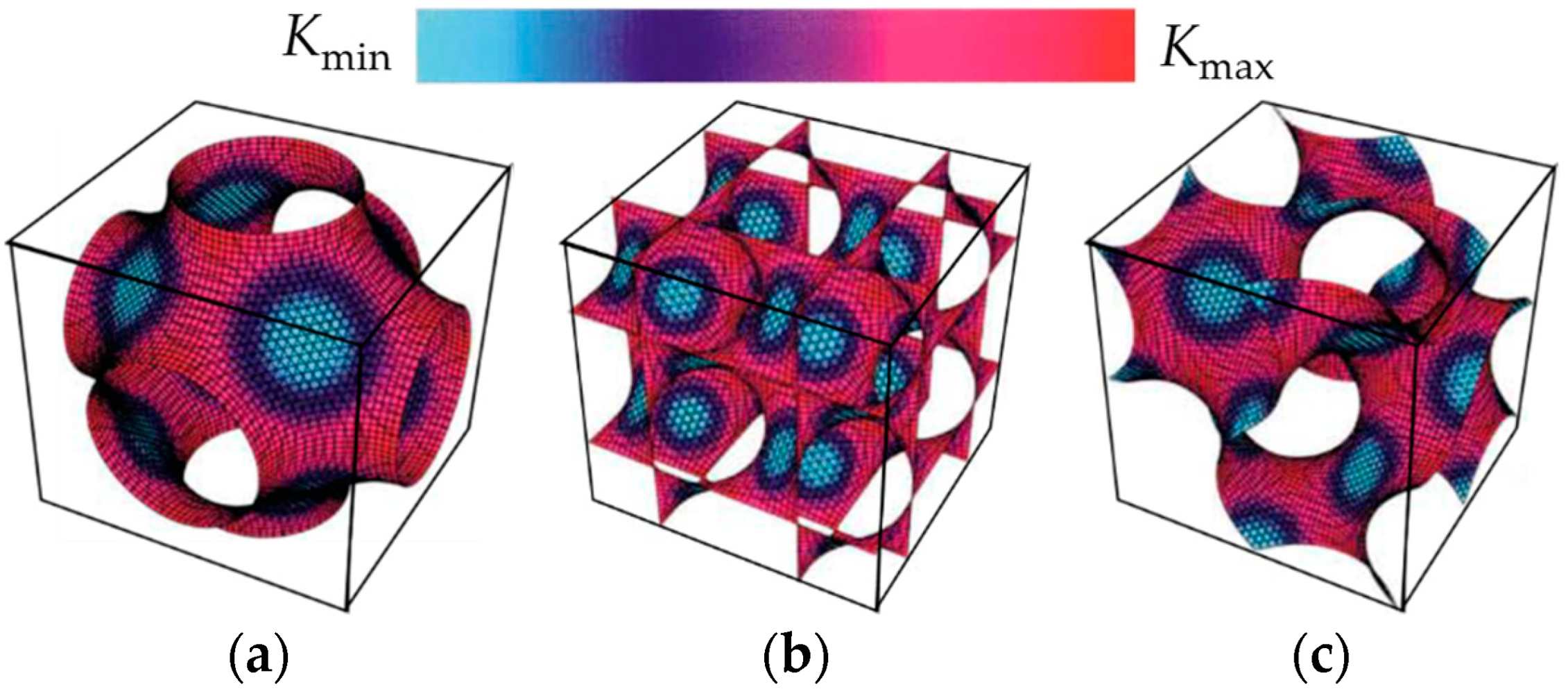
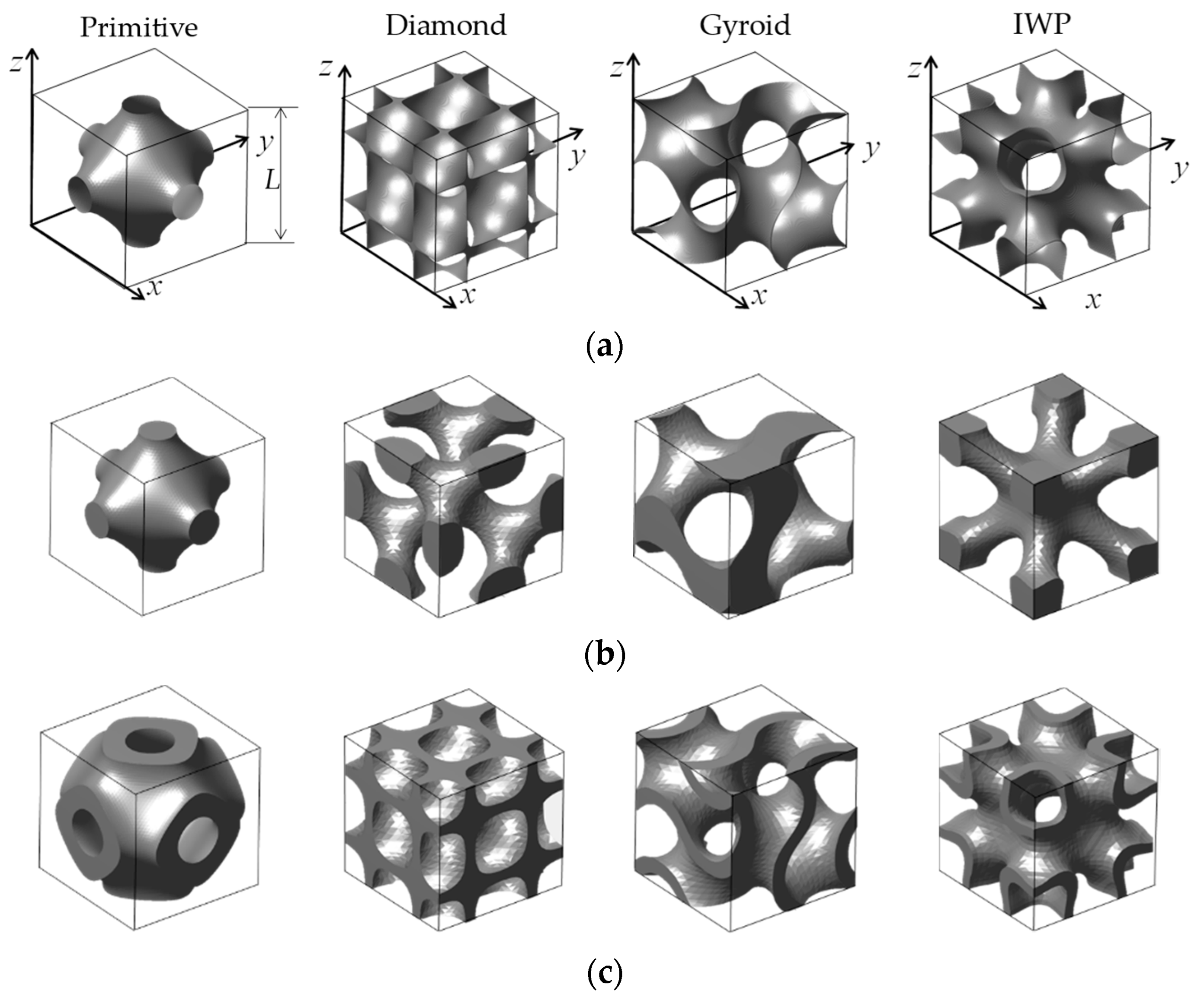

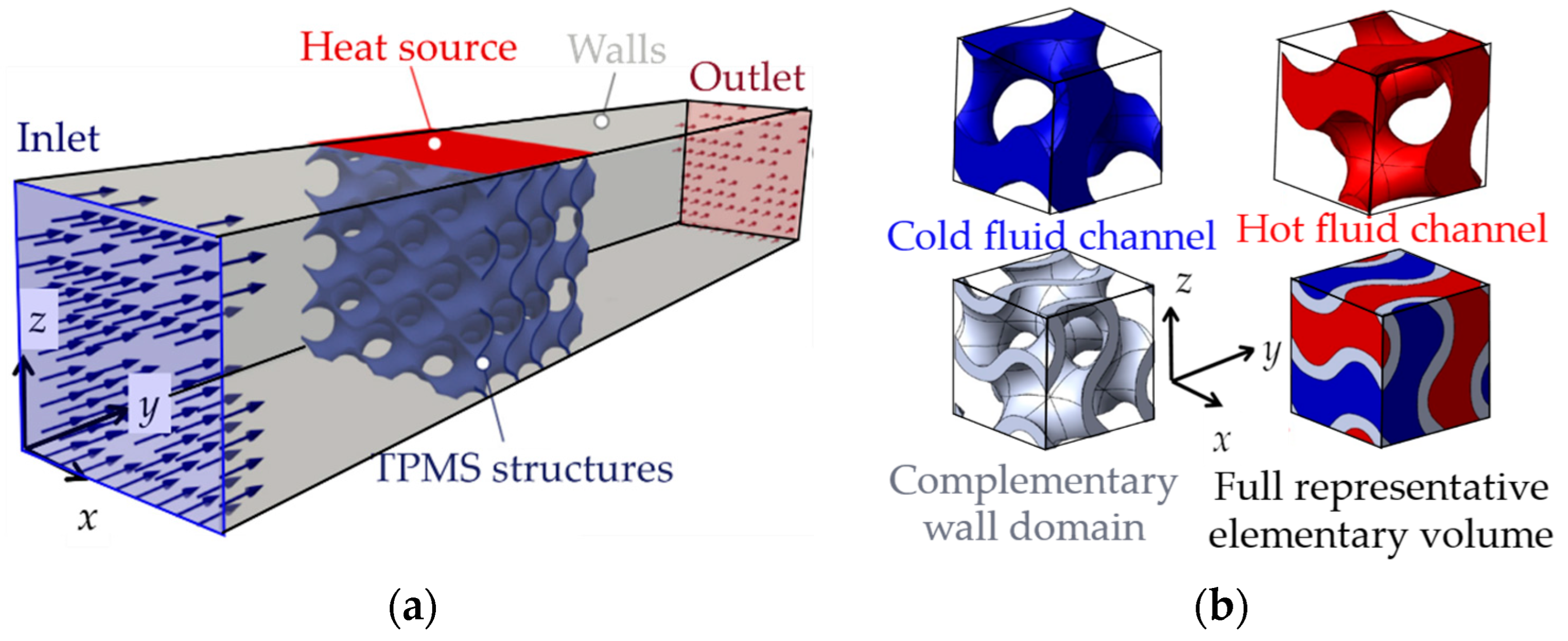
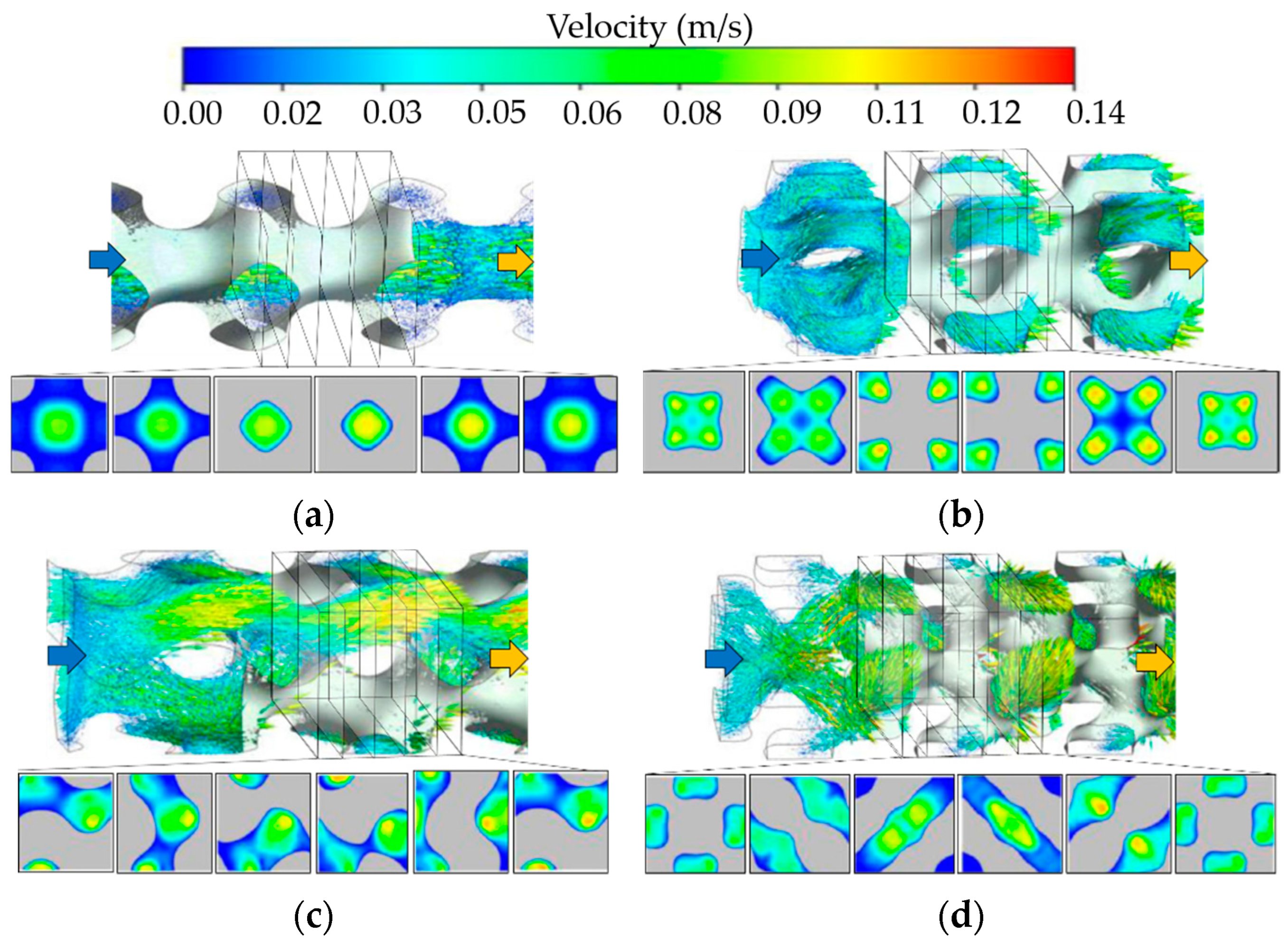
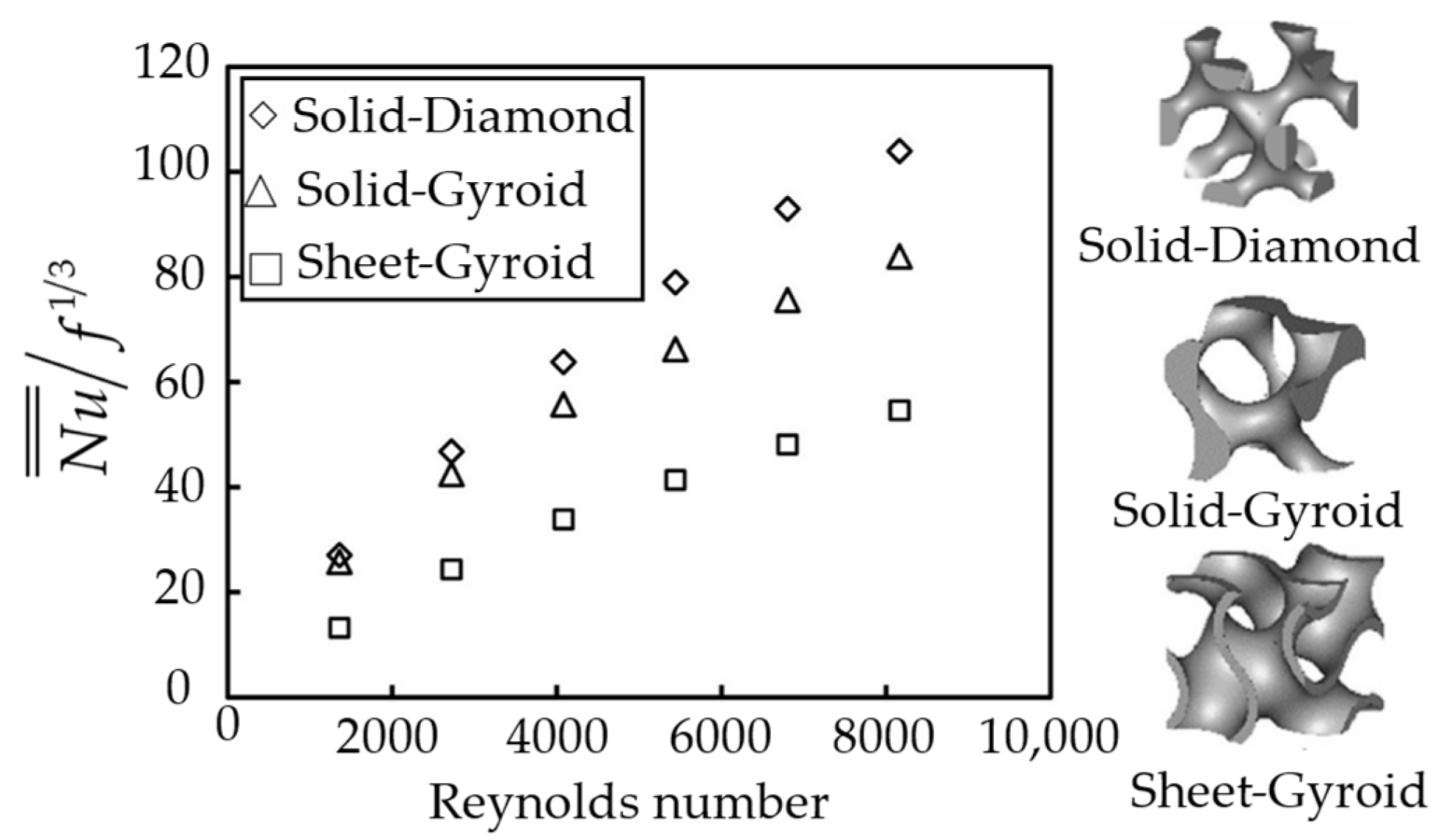

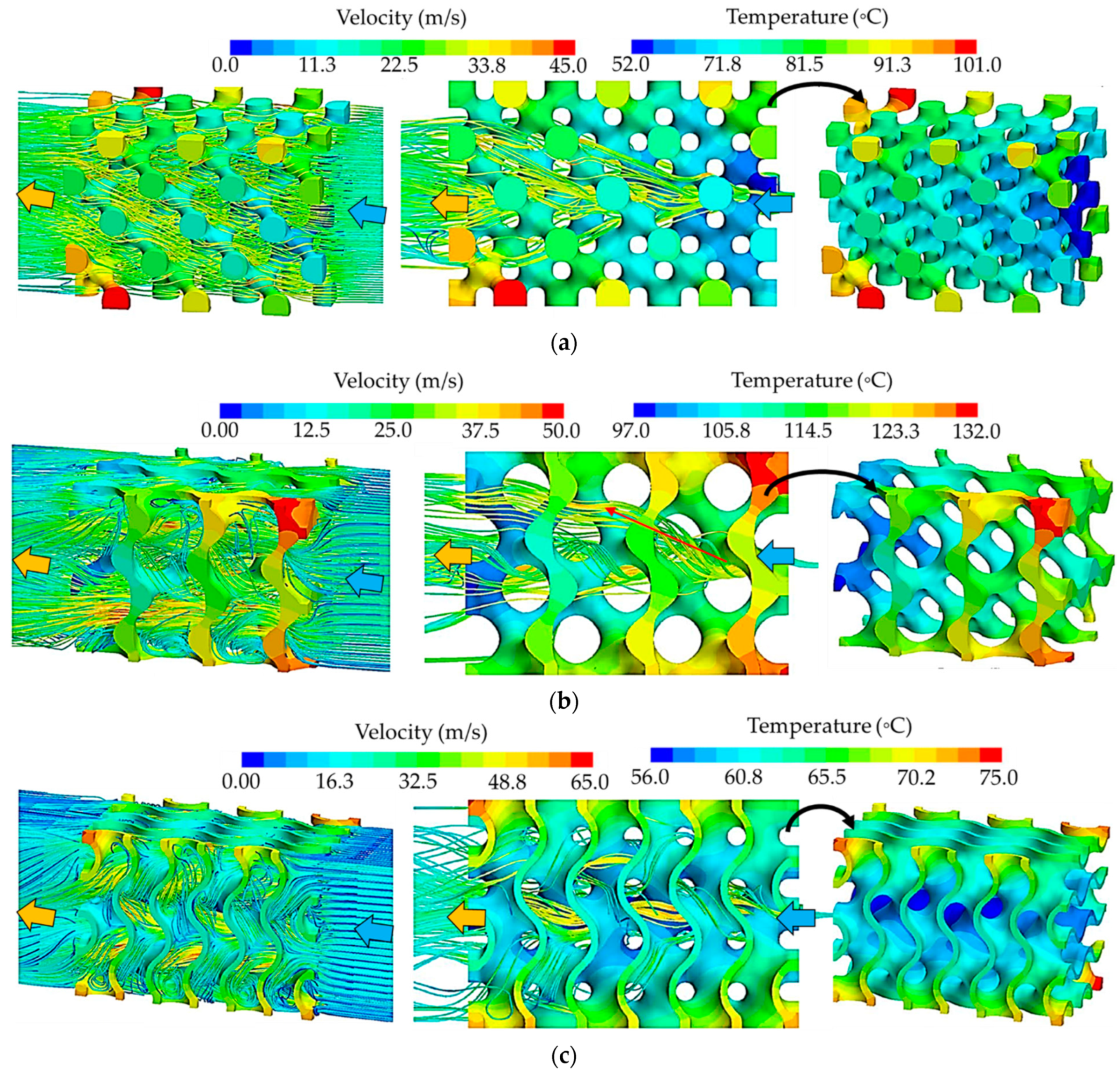
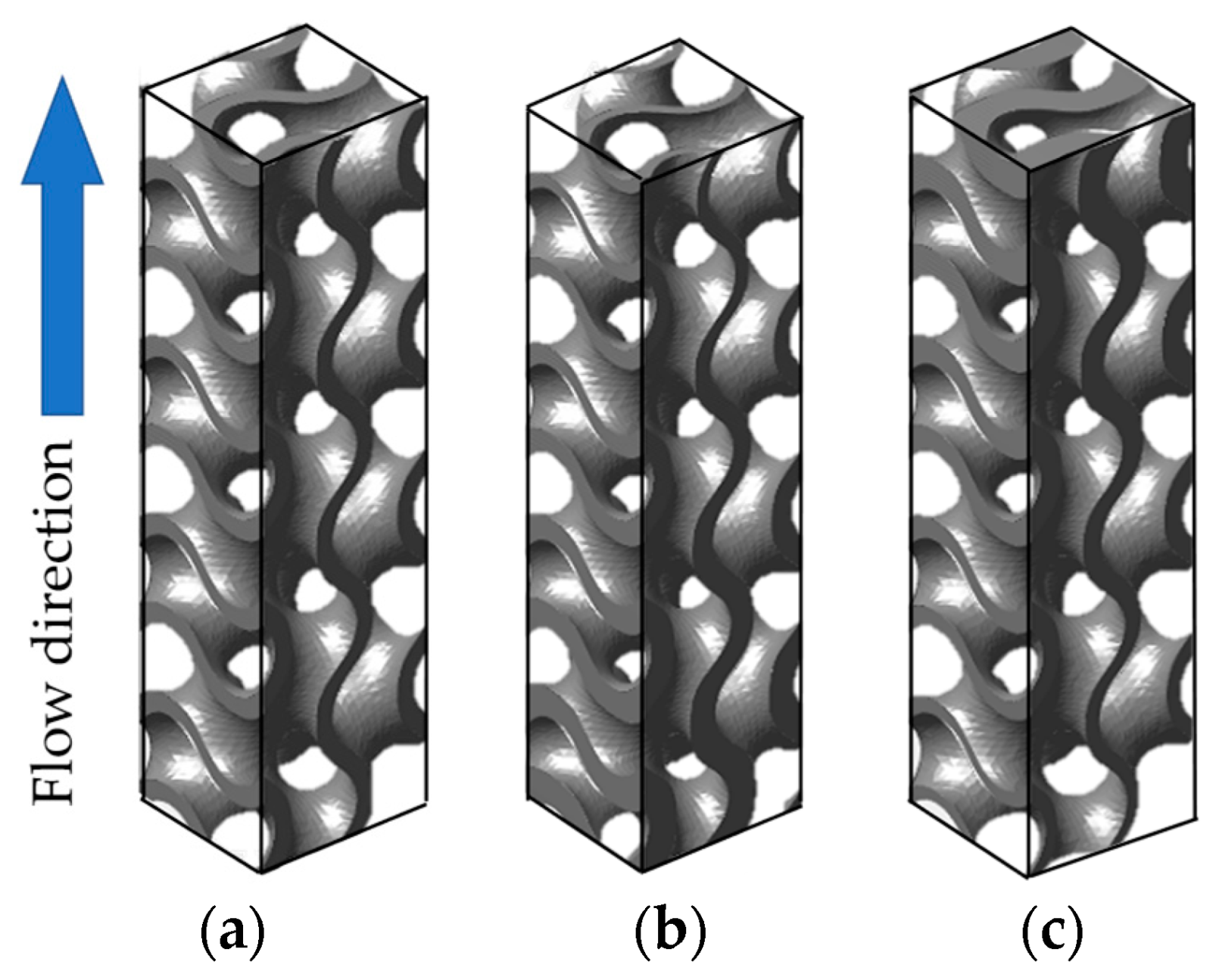

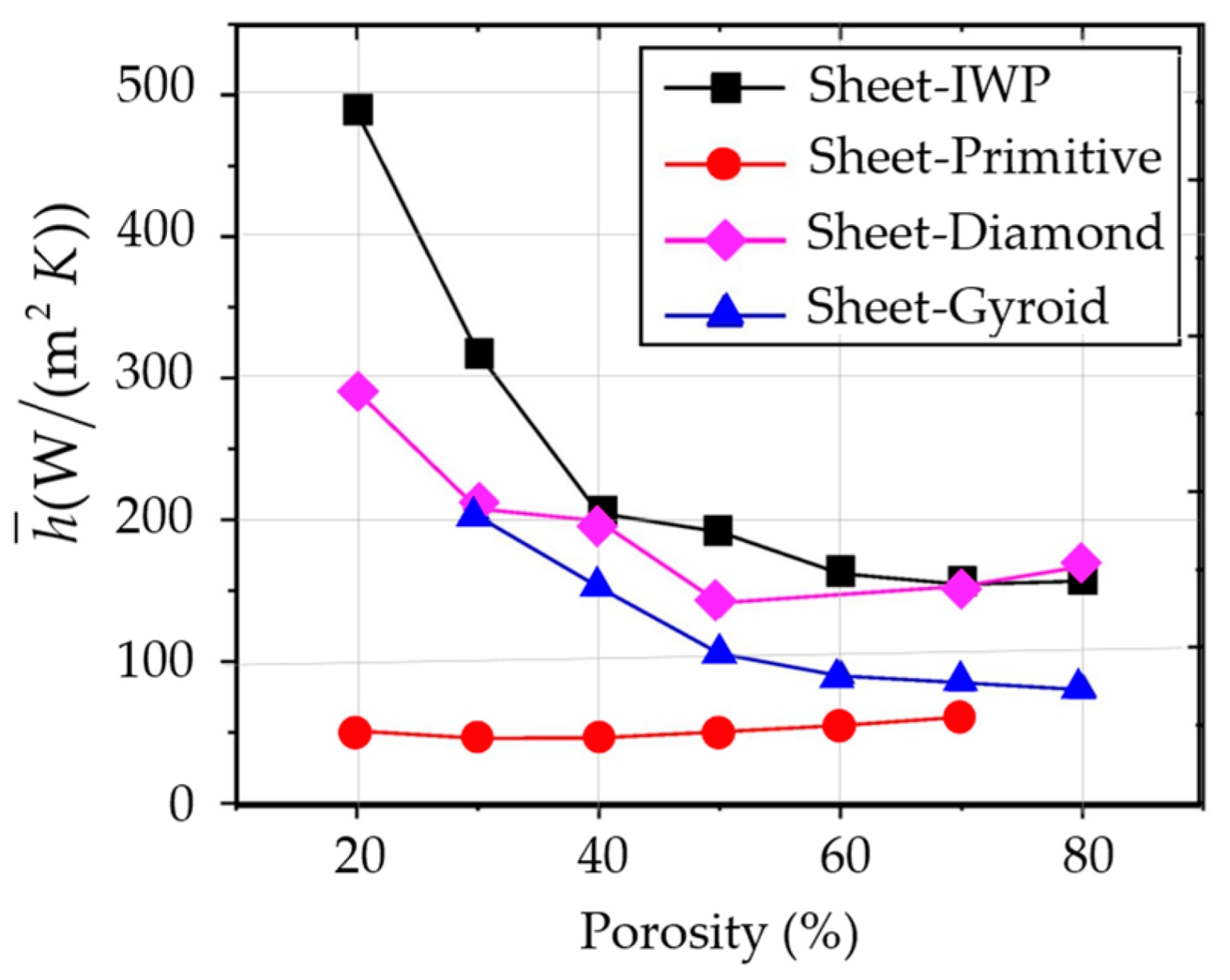

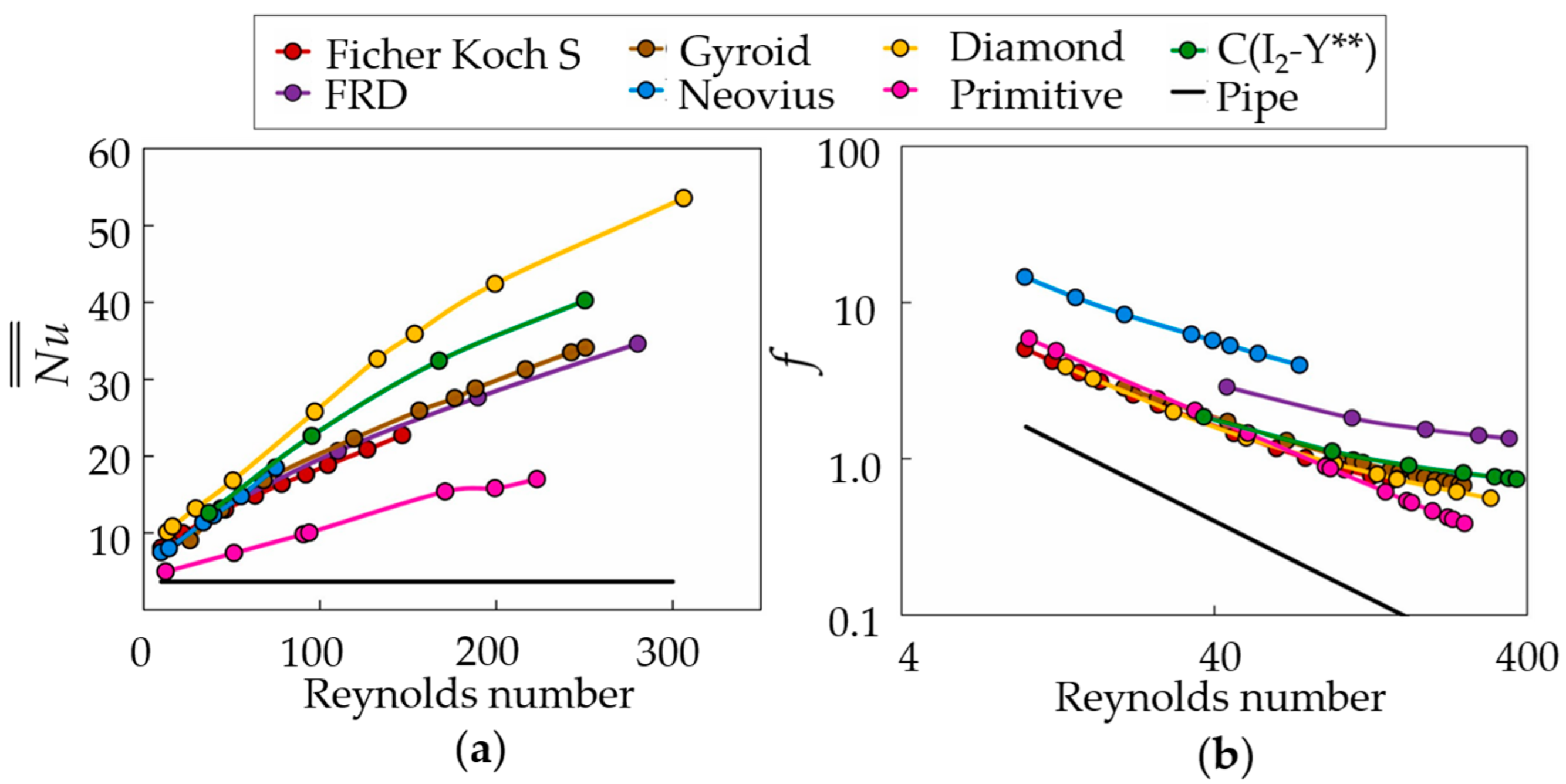


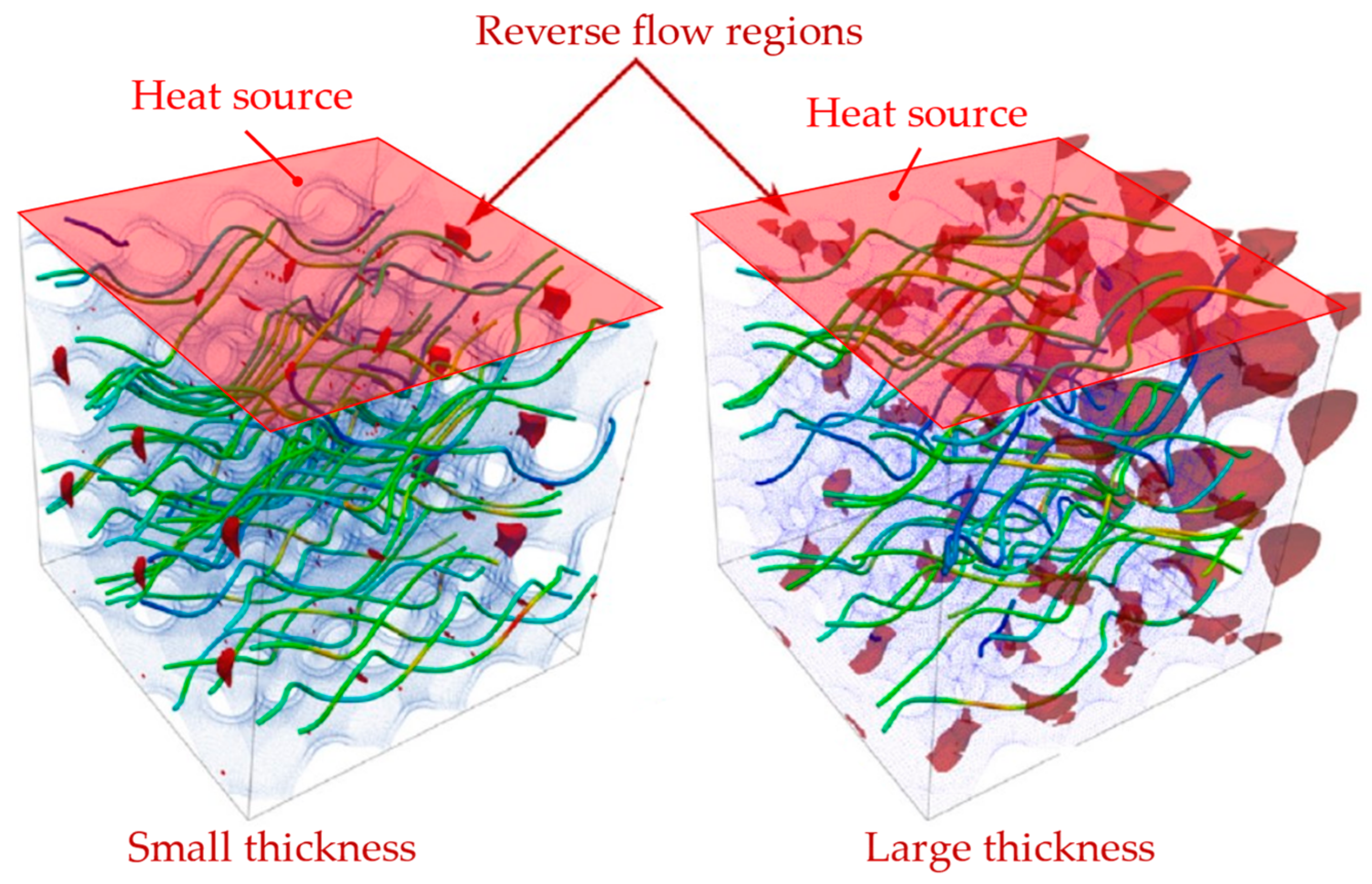
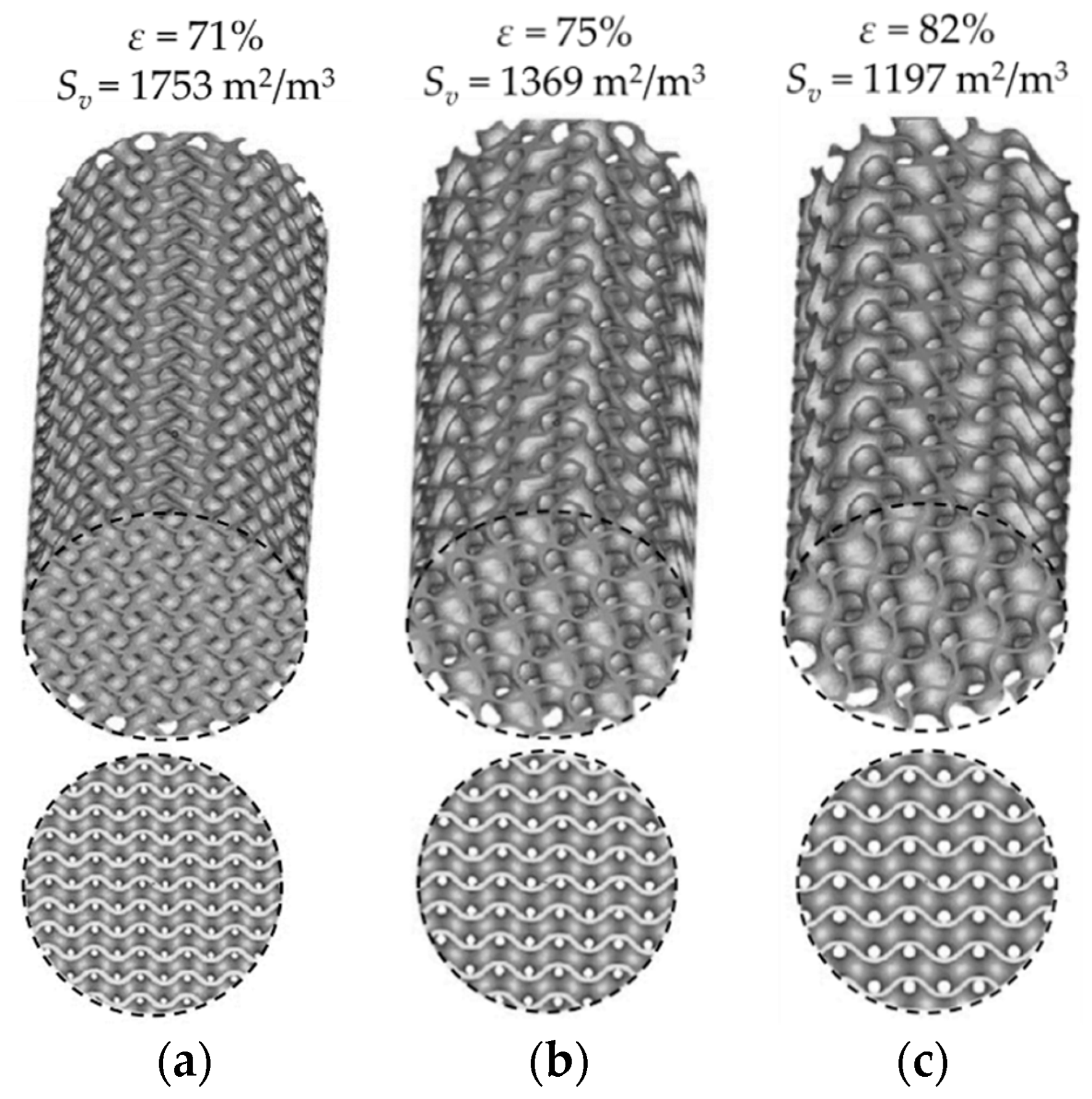
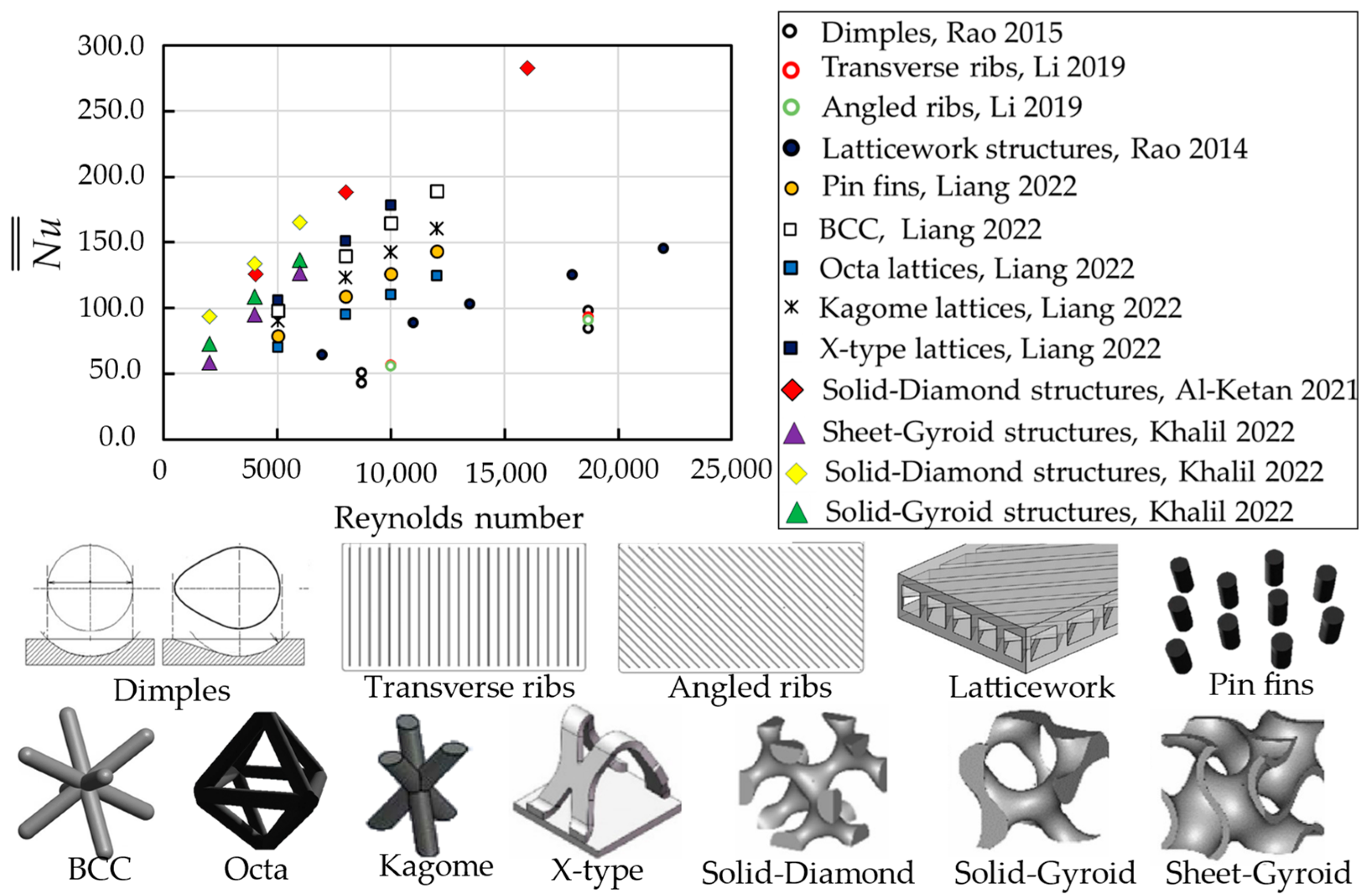
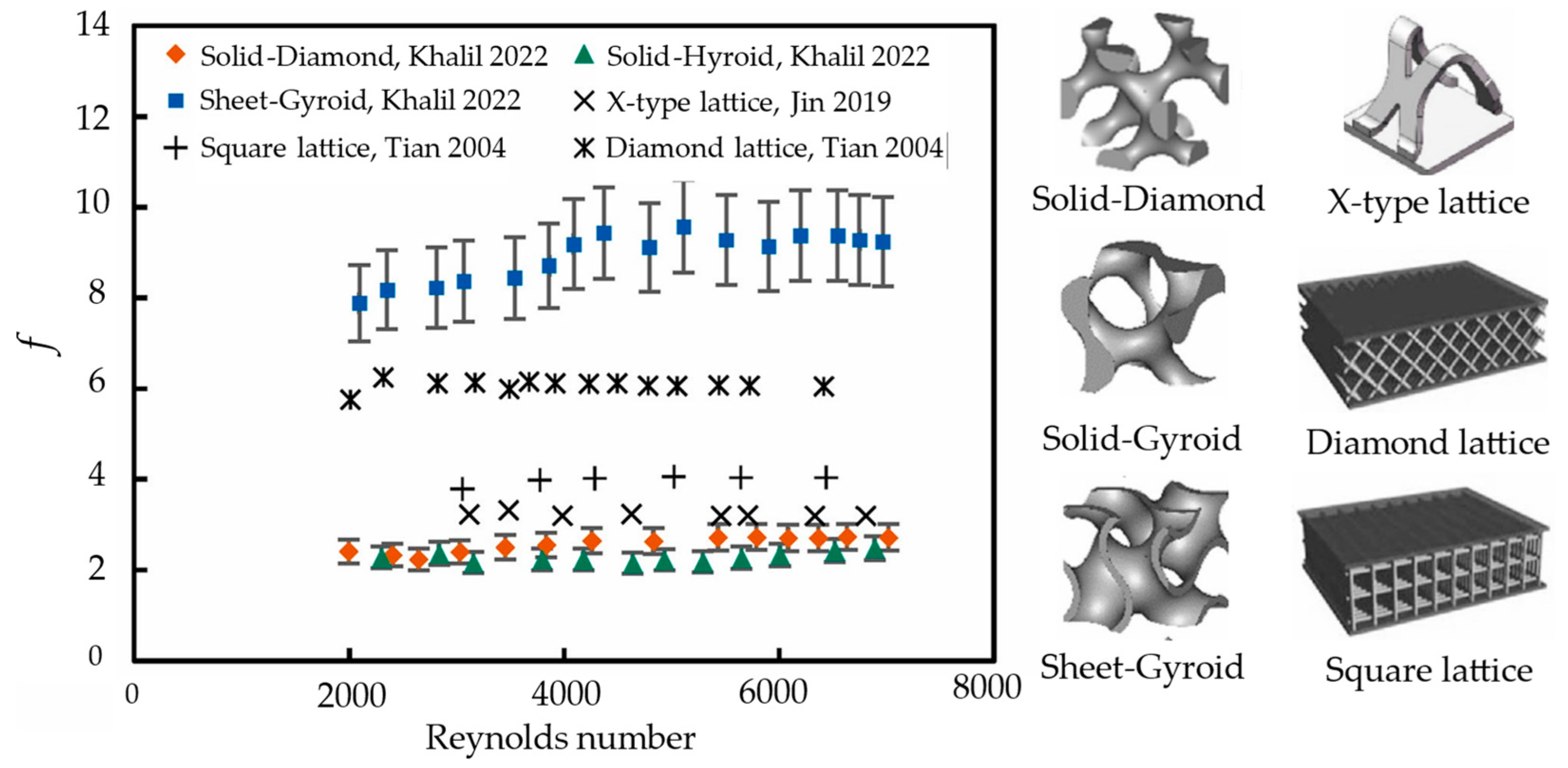
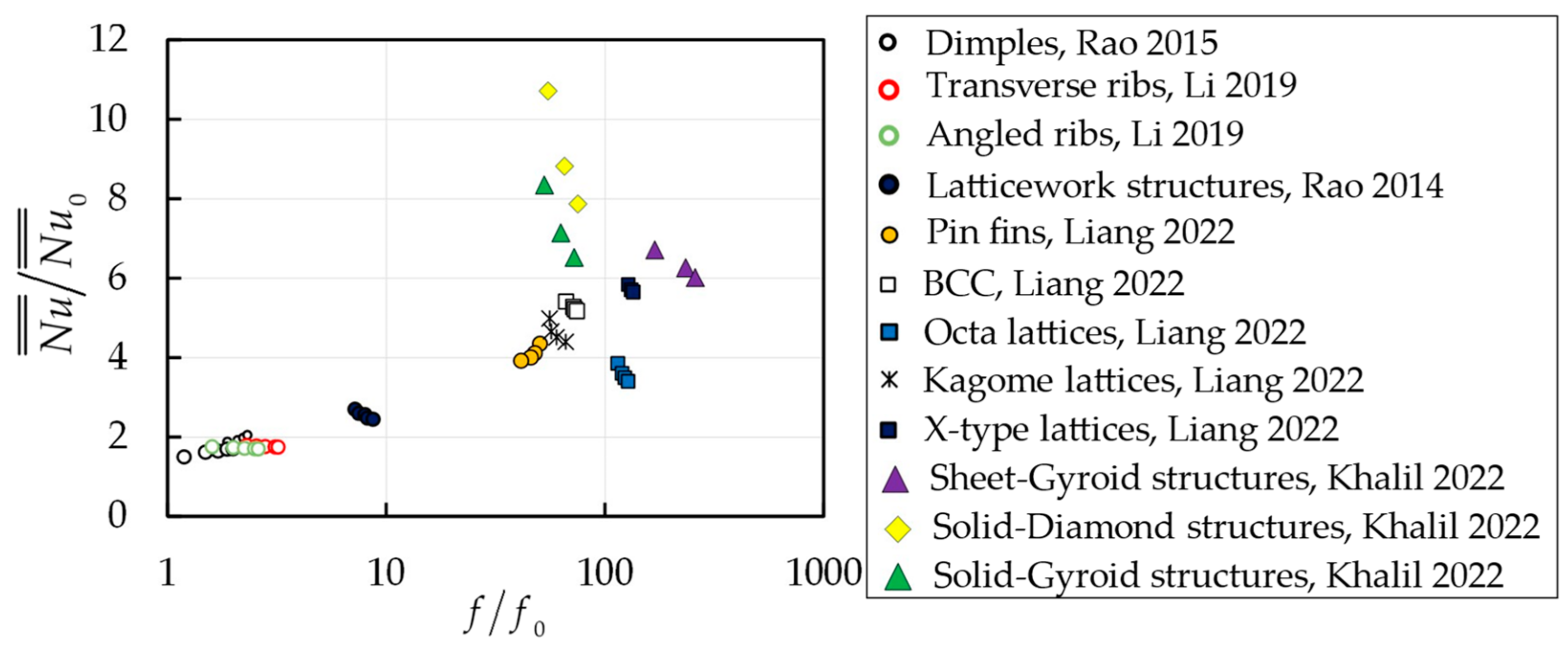
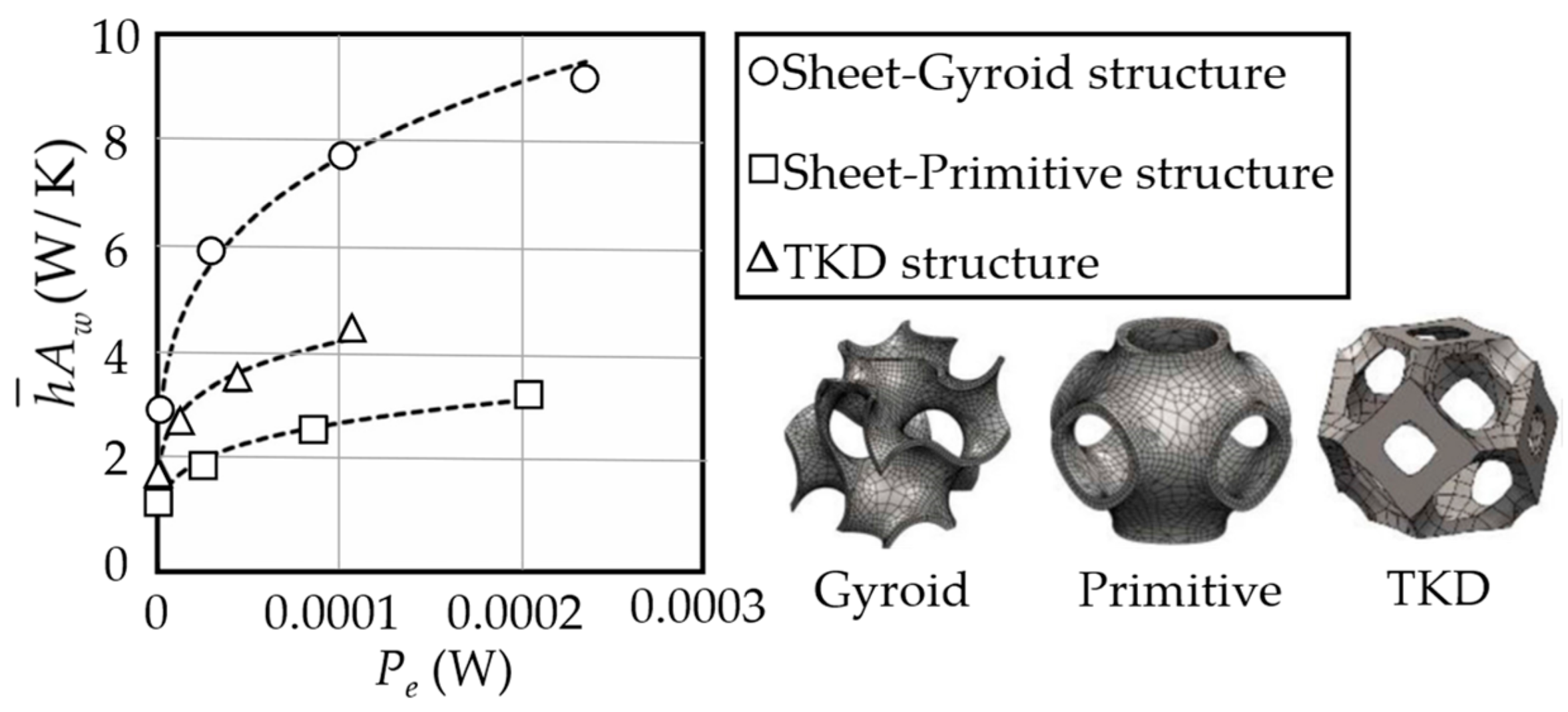
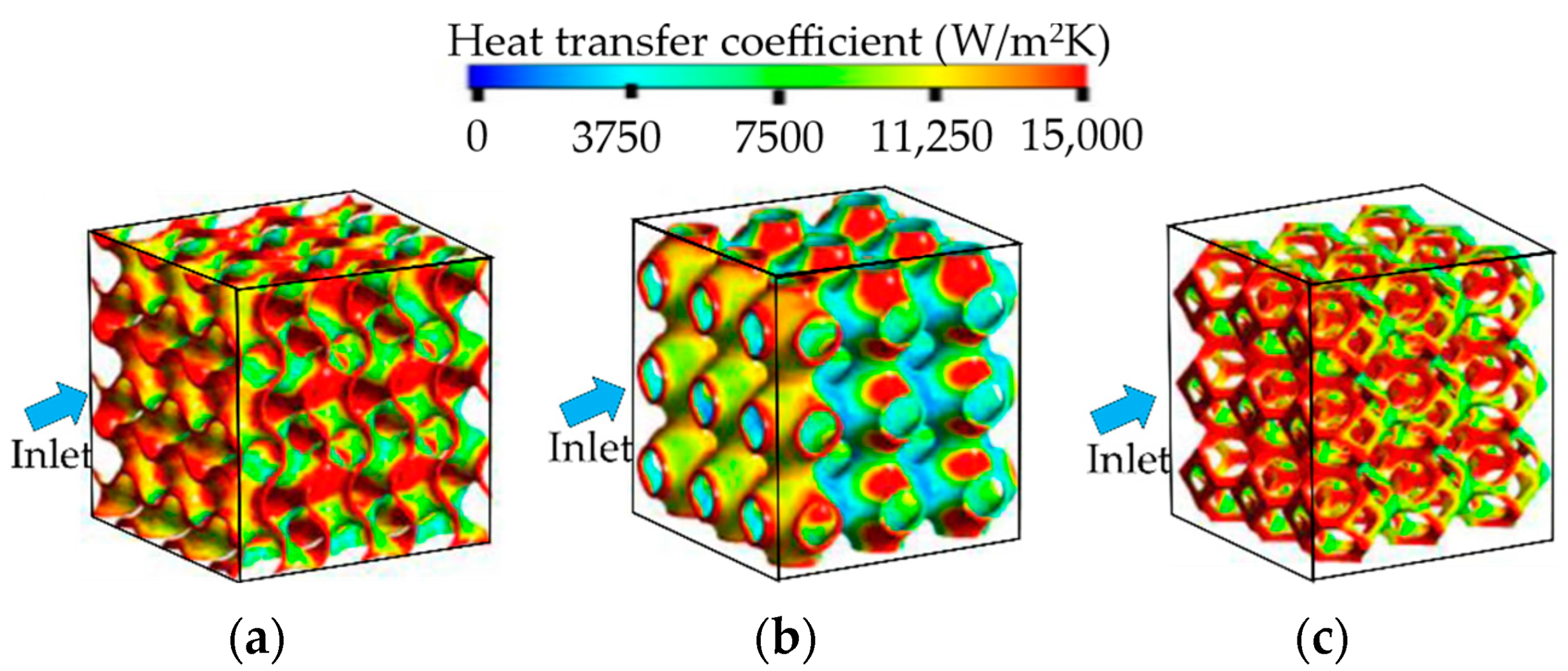

| Ref. | TPMS | Method | Flow Condition | Significant Findings |
|---|---|---|---|---|
| [71] | Diamond, IWP, Gyroid, and Primitive | EXP. 1 and NUM. 2 | Re ≤ 15 |
|
| [51] | Diamond | EXP. | Volumetric flow rate = 5.05–10.10 × 10−5 m3/s |
|
| [77] | Gyroid | NUM. | V = 10–20 mm/s. |
|
| [54] | Diamond, IWP, Gyroid, and Primitive | NUM. | Re = 5–150 |
|
| [78] | Diamond and Gyroid | EXP. and NUM. | Volumetric flow rate = 0.5–9 L/min. |
|
| [56] | Diamond, Gyroid, and Primitive | NUM. | Re ≤ 3 |
|
| [62,79] | Diamond and Gyroid | NUM. (SST turbulence model) | Hot domain: Re = 2300–53,000. Cold domain: Re = 3000–70,000 Working fluid: Supercritical carbon dioxide (sCO2) |
|
| [80] | Diamond, Gyroid, and Primitive | EXP. | Volumetric flow rate = 1.8–9.6 L/min. |
|
| [81] | Gyroid | EXP. | Re = 10–40 |
|
| [82] | Diamond, Fischer Koch S | NUM. | Re = 10–150 |
|
| [83] | Gyroid and Primitive | NUM. (realizable k–ε) | Re = 25,500–63,700 |
|
| [55] | Diamond, Gyroid, Primitive, Fischer Koch S, FRD, IWP, PNS 3 | NUM. | Re = 10–300 |
|
| Ref | AM Method | Material | Size/Thickness | 3D-Printed TPMS Example |
|---|---|---|---|---|
| [48] | SLM | AlSi10Mg |
| 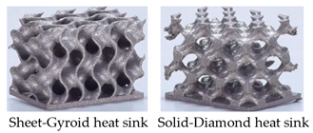 |
| [77] | DMLS | Stainless steel |
|  |
| [67] | SLS | PA 2202 black thermoplastic |
|  |
| [80] | SLA | ABS-like resin |
| 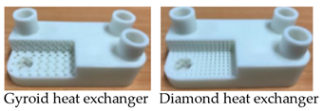 |
| [71] | DLP | WIC100A photo-polymerizable resin |
| 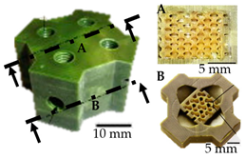 |
| [81] | SLA | PlasGRAY V2 photopolymer resin |
| 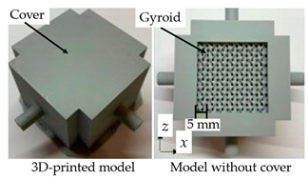 |
| [70] | FDM | Thermoplastic |
|  |
Publisher’s Note: MDPI stays neutral with regard to jurisdictional claims in published maps and institutional affiliations. |
© 2022 by the authors. Licensee MDPI, Basel, Switzerland. This article is an open access article distributed under the terms and conditions of the Creative Commons Attribution (CC BY) license (https://creativecommons.org/licenses/by/4.0/).
Share and Cite
Yeranee, K.; Rao, Y. A Review of Recent Investigations on Flow and Heat Transfer Enhancement in Cooling Channels Embedded with Triply Periodic Minimal Surfaces (TPMS). Energies 2022, 15, 8994. https://doi.org/10.3390/en15238994
Yeranee K, Rao Y. A Review of Recent Investigations on Flow and Heat Transfer Enhancement in Cooling Channels Embedded with Triply Periodic Minimal Surfaces (TPMS). Energies. 2022; 15(23):8994. https://doi.org/10.3390/en15238994
Chicago/Turabian StyleYeranee, Kirttayoth, and Yu Rao. 2022. "A Review of Recent Investigations on Flow and Heat Transfer Enhancement in Cooling Channels Embedded with Triply Periodic Minimal Surfaces (TPMS)" Energies 15, no. 23: 8994. https://doi.org/10.3390/en15238994








